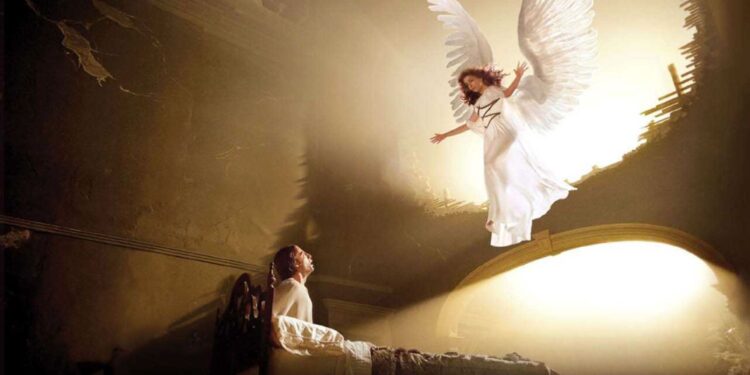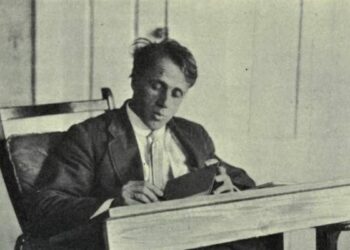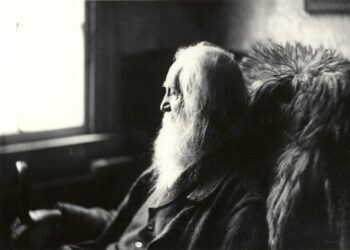Table of Contents
ToggleIntroduction
Angels In America A Gay Fantasia summary By Tony Kushner Tony Kushner’s Angels in America: A Gay Fantasia on National Themes is often hailed as one of the greatest plays of the modern American theater canon. Its profound exploration of the AIDS crisis, LGBTQ+ rights, and the broader political landscape of the 1980s allows it to transcend its historical context, addressing universal themes of love, suffering, identity, and survival. Through a combination of character-driven narrative, allegorical elements, and historical commentary, Kushner’s play captures the complexities of the personal and societal transformations occurring during the Reagan era.
In Angels in America, Kushner uses his characters’ struggles to critique the social, political, and religious forces that shaped the lives of those living with AIDS, particularly the LGBTQ+ community, and explores the harsh realities of life under an administration that ignored or downplayed the impact of the AIDS epidemic. The play’s layered themes are enriched by Kushner’s deft use of magical realism, in which angels and hallucinations appear alongside the deeply human struggles of his characters. Through this, Kushner elevates the personal to the mythical, intertwining individual crises with broader societal and political narratives.
Summary of Angels in America
Angels in America takes place in the 1980s in New York City, during the height of the AIDS crisis, and follows the intersecting lives of a variety of characters who are each facing personal, political, and social crises. The play is divided into two parts: Millennium Approaches and Perestroika.
Part One: Millennium Approaches
The first part of Angels in America introduces us to the character of Prior Walter, a young gay man who has been diagnosed with AIDS. His partner, Louis Ironson, struggles with the emotional and physical implications of Prior’s illness. Louis’ internal conflict, torn between love for Prior and fear of being infected, leads him to abandon Prior, an act that deepens Prior’s suffering and isolates him even more.
Simultaneously, we meet Joe Pitt, a closeted Mormon lawyer who works for a powerful law firm. He is married to Harper Pitt, a woman struggling with mental health issues and prescription drug addiction. As Joe’s internal conflict grows, he is faced with the challenge of reconciling his religious beliefs and his emerging romantic feelings for Louis.

Another central character is Roy Cohn, a real-life historical figure and a conservative lawyer who is instrumental in shaping American politics in the mid-20th century. Cohn is diagnosed with AIDS but refuses to accept it, choosing instead to claim that he is suffering from liver cancer. His refusal to acknowledge his sexuality and his illness symbolizes the ways in which certain powerful figures in society denied the reality of the AIDS epidemic, just as Cohn denies his own culpability in perpetuating harmful political systems.
The play’s surreal elements emerge as Prior, near death, is visited by a heavenly angel, who declares him to be a prophet. The arrival of the angel sets in motion a series of supernatural events that will play out in the second part of the play. Meanwhile, Prior’s friends, including his former lover Louis and his nurse Belize—a former drag queen—play a crucial role in his emotional support. Prior’s illness and the challenges of his relationships highlight the personal and social tensions of the period.
Part Two: Perestroika
In the second part of Angels in America, the political and supernatural elements become even more pronounced. The character of Prior takes on a more pronounced prophetic role, grappling with his own suffering and the implications of the angel’s visit. As his illness advances, he is forced to come to terms with both his personal mortality and his responsibility to deliver a message to the world.
Joe Pitt’s emotional and sexual turmoil deepens as he confronts the choices he has made. His struggle with his sexuality continues to haunt his marriage, and his ultimate decision to come out to his wife Harper leads to a collapse in their relationship. At the same time, Harper begins to experience vivid hallucinations, most notably encountering Mr. Lies, a mysterious character who embodies her delusions and fantasies.
Roy Cohn, nearing death, continues his interactions with Belize, who criticizes Cohn for his hypocrisy, cruelty, and role in maintaining the systems that oppress marginalized people. Belize offers a voice of moral clarity, contrasting sharply with Cohn’s venomous rhetoric. Cohn’s refusal to acknowledge his homosexuality and his eventual death are powerful symbols of the denial and harm caused by his ruthless pursuit of power.
The play concludes with a dramatic confrontation between Prior and the angel, during which Prior rejects the angel’s message of apocalyptic change. Instead, he chooses to embrace life, accepting that survival—and the possibility of love and hope—are worth pursuing, despite the overwhelming challenges posed by his illness and society’s neglect. This final act of defiance represents the play’s larger theme of transformation, offering a poignant message about the resilience of the human spirit.
Read more
Themes in Angels in America
1. AIDS and the Body
At the core of Angels in America is the AIDS epidemic, which looms over every aspect of the narrative. The play’s characters, particularly Prior Walter, are physically and emotionally ravaged by the disease. Prior’s bodily decay, as well as his emotional and psychological deterioration, are central to the play’s exploration of the AIDS crisis and its impact on the LGBTQ+ community. The bodies of the characters become symbolic of the larger neglect and suffering caused by the epidemic, especially in a society that was initially slow to recognize its gravity.
The physicality of AIDS in the play is not just about the disease’s devastating effects but also about how it intersects with social and political forces. Characters like Roy Cohn, who refuses to acknowledge his diagnosis, exemplify the toxic intersection of denial and political power. AIDS is portrayed as a disease that not only attacks the body but also symbolizes a broader societal illness: the systemic indifference to marginalized groups and the refusal of those in power to acknowledge the lives of those affected by the crisis.Angels In America A Gay Fantasia summary By Tony Kushner
2. Identity and Sexuality
The theme of identity, particularly sexual identity, is a central concern throughout Angels in America. Many of the characters are deeply conflicted about their sexual identities. Louis Ironson’s abandonment of Prior is driven by his fear of the implications of being in a relationship with someone who has AIDS, as well as his unresolved guilt and inability to reconcile his love for Prior with his desire for something “normal” in his life. Joe Pitt’s denial of his homosexuality and his relationship with Louis highlight the tension between religious convictions, social expectations, and personal identity.Angels In America A Gay Fantasia summary By Tony Kushner
The play also explores how sexuality is shaped by larger societal forces, such as the conservative politics of the Reagan administration. Characters like Joe and Roy embody the internalized homophobia that stems from societal rejection of homosexuality. In contrast, Belize represents a more liberated queer identity, offering a counterpoint to the more repressed characters.Angels In America A Gay Fantasia summary By Tony Kushner
Read more
3. Politics and Power
Angels in America is heavily political, using the personal stories of its characters to critique the policies of the Reagan administration, particularly its inaction on the AIDS epidemic. Roy Cohn serves as the play’s embodiment of conservative political power, his character representing the corrupt and self-serving nature of the political elite. His refusal to acknowledge AIDS as an issue and his dismissive attitude toward the suffering of others underscore the political neglect that defined the era.Angels In America A Gay Fantasia summary By Tony Kushner
The play critiques the larger political structures that allow the suffering of marginalized groups, particularly the LGBTQ+ community, to persist. Through Cohn’s rise and fall, the play shows how power, when exercised without empathy, can lead to both personal and societal devastation.Angels In America A Gay Fantasia summary By Tony Kushner
4. Religion and Spirituality
Religion and spirituality are significant themes in Angels in America, particularly in the way that characters grapple with their faith in the face of personal crisis. Joe Pitt’s Mormon faith is a source of both comfort and conflict as he struggles with his sexuality. His refusal to come to terms with his homosexuality is rooted in his religious beliefs, which condemn same-sex relationships.Angels In America A Gay Fantasia summary By Tony Kushner
Meanwhile, Prior’s interactions with the angel represent the play’s exploration of divinity and spirituality. The angel’s visitation suggests that there is a larger cosmic plan, but Prior rejects the angel’s call to fulfill a prophetic role, instead choosing to embrace life and its uncertainties. This act of defiance serves as the play’s ultimate spiritual message—that human resilience and the will to survive are greater than any apocalyptic vision.
5. Love and Relationships
At its core, Angels in America is a play about love—its complexities, its challenges, and its transformative power. The relationships between Louis and Prior, Joe and Harper, and Roy and Belize illustrate how love can be both a source of immense joy and profound pain. Love in the play is not idealized but portrayed as a force that both sustains and destroys.Angels In America A Gay Fantasia summary By Tony Kushner

In the face of disease, betrayal, and rejection, love becomes a mechanism for survival. Prior’s journey, in particular, highlights the transformative power of love—his relationships with his friends and his refusal to succumb to the angel’s call are acts of defiance rooted in love for life and those around him. This theme is ultimately redemptive, showing that love, even in its most difficult forms, can provide strength and hope.Angels In America A Gay Fantasia summary By Tony Kushner
Read more
(FAQ)
1. What is the primary theme of Angels in America?
The primary theme of Angels in America is the intersection of personal, political, and social crises, particularly the AIDS epidemic and the marginalization of LGBTQ+ individuals during the 1980s. The play explores themes of identity, sexuality, power, religion, and love, critiquing the societal forces that shaped the lives of those living with AIDS.
2. How does Kushner use magical realism in the play?
Magical realism in Angels in America is employed through elements like the arrival of the angel and Prior’s prophetic visions. The blend of the real and the fantastical heightens the emotional stakes of the characters’ struggles, making their personal crises take on larger cosmic and spiritual significance.
3. What role does Roy Cohn play in the play’s critique of politics?
Roy Cohn serves as a representation of the conservative political elite, particularly during the Reagan era. His character is used to critique the hypocrisy and cruelty of those in power, especially regarding their treatment of marginalized communities during the AIDS epidemic. His refusal to acknowledge his homosexuality and AIDS diagnosis serves as a metaphor for the denial and neglect faced by the LGBTQ+ community.
4. How does the play address the AIDS crisis?
The play addresses the AIDS crisis by focusing on the devastating impact it had on the lives of individuals, particularly within the LGBTQ+ community. Through characters like Prior Walter and Roy Cohn, Kushner critiques the political and social systems that failed to adequately address the epidemic, offering a poignant commentary on the systemic neglect of those affected.
5. Why is Angels in America considered an important work?
Angels in America is considered one of the most important American plays because it tackles crucial social, political, and cultural issues with depth, intelligence, and emotional resonance. Its critique of Reagan-era politics, exploration of LGBTQ+ identity, and representation of the AIDS epidemic make it an essential work for understanding a pivotal moment in American history.

















